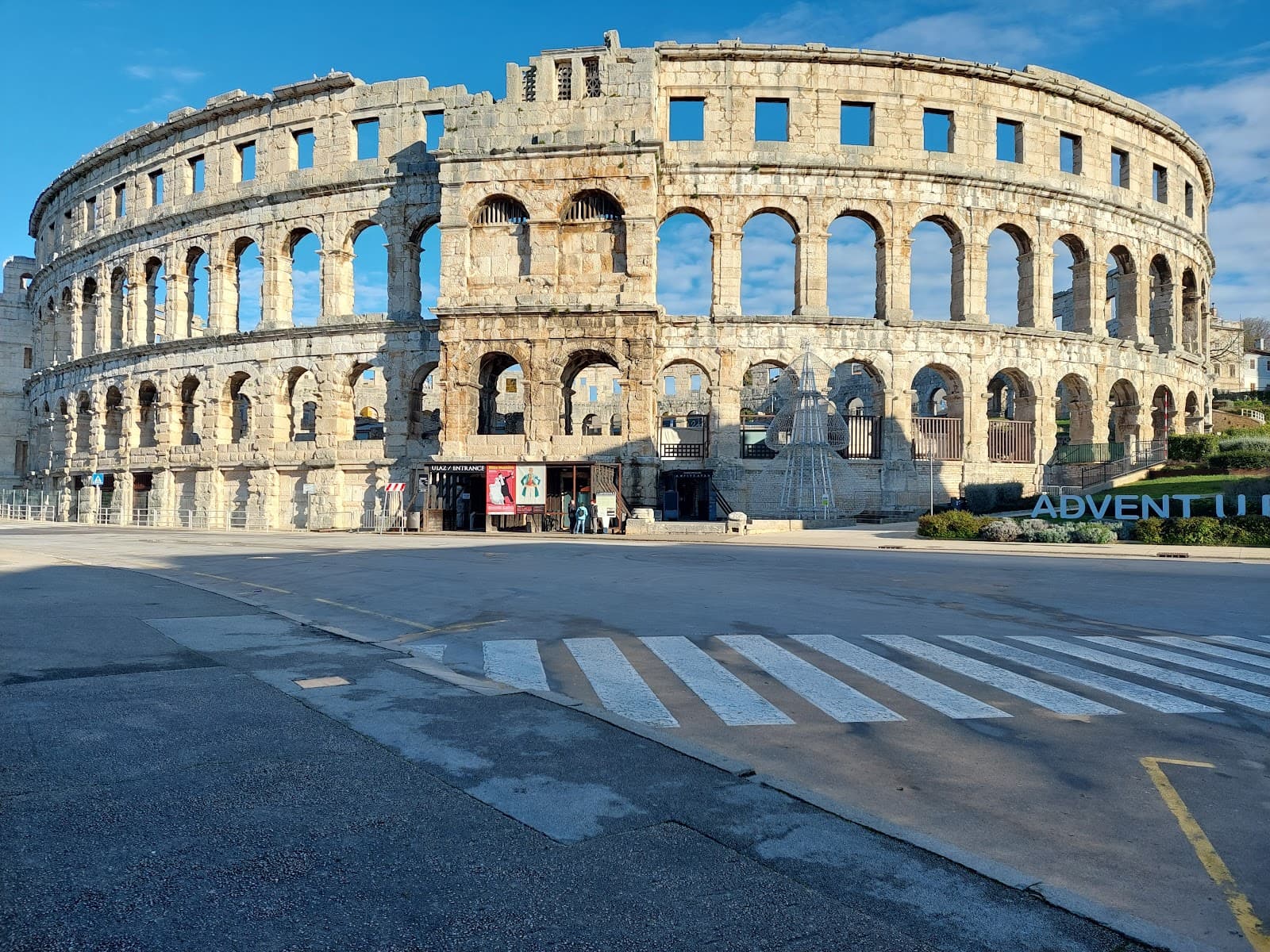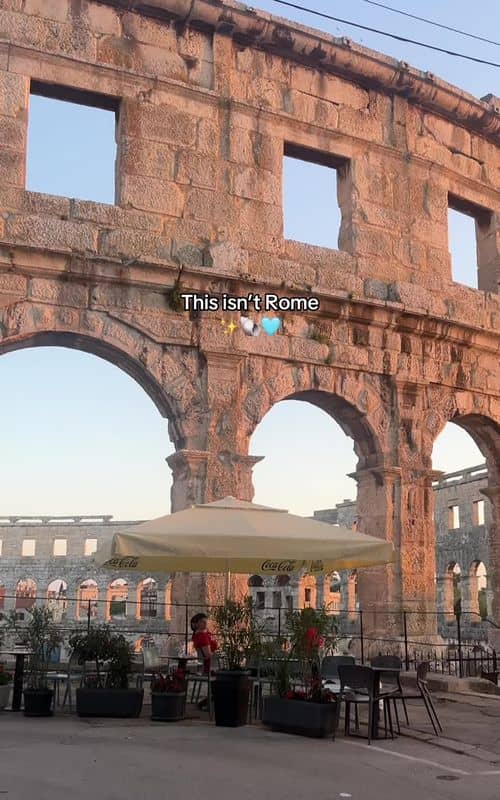
Small Roman Theatre
A 1st-century AD Roman theatre in Pula, Croatia, offering a glimpse into ancient performances and hosting modern concerts.
Highlights
Must-see attractions

Social
From TikTok & Reddit
Best Time
Golden hour for photos

Small Roman Theatre
Best Time
Golden hour for photos
Highlights
Must-see attractions
A 1st-century AD Roman theatre in Pula, Croatia, offering a glimpse into ancient performances and hosting modern concerts.
"Smaller than the Arena, but without the touristy bustle, offering a lovely glimpse into Roman life."

📸 Off-Peak Photo Ops
Visit during off-peak hours for clearer shots and a more peaceful exploration of this historic gem.
🎶 Check Event Schedules
See if there are concerts or performances scheduled; it's a unique way to experience the venue!

Highlights
Discover the most iconic attractions and experiences

Ancient Stage & Seating
Main theatre area
Imagine gladiators and actors on this stage. Only parts remain, but the semicircular seating whispers tales of Roman spectacles.

Small Museum Insights
Adjacent to the theatre
Discover Pula's Roman past with exhibits on olive oil and wine production. A glimpse into daily life.

Concert Venue Ambiance
Theatre floor
Experience live music under the stars in this historic setting. A modern twist on ancient entertainment.
Plans like a pro.
Thinks like you
Planning Your Visit
Timing is Key for Atmosphere
Beyond the Ruins: Event Hub
Best Times
Insider Tips
from TikTok, Instagram & Reddit
📸 Off-Peak Photo Ops
Visit during off-peak hours for clearer shots and a more peaceful exploration of this historic gem.
🎶 Check Event Schedules
See if there are concerts or performances scheduled; it's a unique way to experience the venue!
🚶♀️ Easy City Access
Conveniently located near the city center, making it an easy addition to your Pula itinerary.
🏛️ Compare to Arena
Smaller than the Pula Arena, but offers a different, less crowded historical perspective.
Tips
from all over the internet
📸 Off-Peak Photo Ops
Visit during off-peak hours for clearer shots and a more peaceful exploration of this historic gem.
🎶 Check Event Schedules
See if there are concerts or performances scheduled; it's a unique way to experience the venue!
🚶♀️ Easy City Access
Conveniently located near the city center, making it an easy addition to your Pula itinerary.
🏛️ Compare to Arena
Smaller than the Pula Arena, but offers a different, less crowded historical perspective.
What Travellers Say
Reviews Summary
Visitors appreciate the Small Roman Theatre for its historical significance and its role as a unique event venue, offering a less crowded experience than the Pula Arena. However, some find the remaining structure limited and note that modern event setups can detract from the ancient atmosphere.
"The Small Roman Theatre, dating from the 1st century AD, is nestled on the eastern slope beneath the Pula Citadel. Though much smaller than the Arena, with a capacity of about 4,000–5,000 spectators, it was the cultural heart of Roman Pula, hosting dramatic performances and recitations. While only parts of the stage and the semicircular seating area remain, the site offers a tangible connection to everyday Roman life and the city’s artistic traditions. Its location within the city and proximity to other landmarks make it an evocative stop for history enthusiasts, even if it is not as visually intact as the Arena. The ongoing archaeological work adds a sense of discovery to any visit."
Goran
"Concert I attended was great but I can't believe that you have to sit on bare metal. Setting is ok, but because most of the amphitheatre is covered by metal stands a lot of original feel is lost."
Jadran Bižić
"Nice stopover and off peak allows better photos. Not as comprehensive as Rome’s but without the touristy but. And lovely to see the intact walls, small museum about its olive and wine production"
Rina Ho
What People Like
What People Dislike
Frequently Asked Questions
🚇 🗺️ Getting There
The Small Roman Theatre is conveniently located on the eastern slope beneath the Pula Citadel, making it easily accessible on foot from the city center. It's a short walk from other Pula attractions.
While direct parking at the theatre is limited, there are several public parking lots in Pula's city center that are within walking distance.
Yes, Pula has a bus system that serves the city center, and the theatre is within easy reach of most bus stops in the downtown area.
The Small Roman Theatre is a short walk from the Pula Arena, making it easy to visit both historical sites in one outing.
Many visitors find it best to explore Pula's Roman sites, including the Arena and the Small Roman Theatre, on foot as they are relatively close to each other in the city center.
🎫 🎫 Tickets & Entry
Entry to the Small Roman Theatre itself is often free, especially when no events are taking place. However, if you wish to visit the adjacent museum or attend a specific event, separate tickets may be required.
The Small Roman Theatre is generally accessible during daylight hours when no events are scheduled. For specific event times or museum hours, it's best to check local listings or the Pula Tourism Office.
Typically, exploring the ruins of the Small Roman Theatre is free. However, special events like concerts may have their own admission fees.
While the exterior may be visible at night, access to the site for exploration is usually restricted after dark, unless there is a scheduled evening event.
While there isn't a specific combined ticket for the Small Roman Theatre and the Arena, visiting both is highly recommended and easily done within a single day.
🎫 🏛️ Onsite Experience
You can see remnants of the stage and semicircular seating area, offering a glimpse into Roman dramatic performances. There's also a small museum detailing Pula's history.
Yes, children can explore the ruins and learn about Roman history. The smaller scale compared to the Arena might be more manageable for younger visitors.
Guided tours are not always readily available for the Small Roman Theatre itself, but local guides in Pula may include it in broader historical tours of the city.
The theatre hosts various events, including concerts, theatrical performances, and cultural festivals, blending ancient history with modern entertainment.
A visit to the Small Roman Theatre typically takes about 30-60 minutes, depending on your interest in the museum and whether you're attending an event.
📸 📸 Photography
Late afternoon offers beautiful golden hour light for photography. Visiting during off-peak hours also ensures fewer people in your shots.
Drone usage is typically restricted in historical sites and city centers. It's best to check local regulations with the Pula Tourism Office before flying.
The remaining stage area, the semicircular seating, and the exterior views with the city in the background are popular for photos.
Photography policies during events can vary. It's advisable to check with the event organizers, but generally, personal photos are allowed, though professional shoots might require permission.
A standard camera or smartphone is sufficient. A wide-angle lens can be useful for capturing the scale of the theatre, especially during events.
For Different Travelers
Tailored advice for your travel style
👨👩👧 Families with Kids
Consider visiting during the day when it's less crowded, allowing children to move around more freely. The small museum can also provide engaging insights into Roman life, such as their production of olive oil and wine, which can be interesting for younger minds. It's a great way to introduce children to history in a tangible and accessible way.
🏛️ History Buffs
Pay attention to the ongoing archaeological work, which adds an element of discovery. While it may not be as visually grand as the Arena, its historical context and the insights from the small museum about Pula's Roman economy (olive oil, wine) are invaluable for understanding the region's heritage.
🎶 Music & Arts Lovers
Check the schedule for performances during your visit. While some visitors note that modern seating can detract from the original feel, the overall ambiance of a concert under the stars in a Roman theatre is unparalleled. It's a chance to experience art in a truly historic setting.
Deep Dives
In-depth insights and expert knowledge
A Glimpse into Roman Pula
While only portions of the original structure remain, ongoing archaeological work continues to uncover more about its history and significance. The site provides a more intimate historical experience compared to larger Roman amphitheatres, allowing for a closer appreciation of the architectural details and the atmosphere of ancient performances. The presence of a small museum on-site further enhances the visitor experience by providing context on Pula's Roman heritage, particularly its historical importance in olive oil and wine production.
Many travelers find the Small Roman Theatre to be a charming and less crowded alternative to more famous Roman ruins. It offers a unique opportunity to step back in time and imagine the vibrant cultural scene that once thrived here. Its accessibility within the city makes it an easy and rewarding stop for anyone interested in history and archaeology.
The Theatre as a Modern Venue
Concerts featuring renowned musicians have graced the stage, transforming the ancient space into a dynamic performance arena. While the addition of modern seating and stage setups is necessary for these events, it can sometimes alter the original feel of the theatre, as noted by some visitors. Nevertheless, the blend of ancient architecture and modern performance art offers a compelling cultural fusion.
Attending an event here provides a dual experience: appreciating the historical architecture and enjoying a live performance. It's a testament to the enduring legacy of Roman structures that they can continue to serve cultural purposes centuries later. Checking the local event calendar for Pula is highly recommended to see if any performances coincide with your visit.


Social
from TikTok, Instagram & Reddit